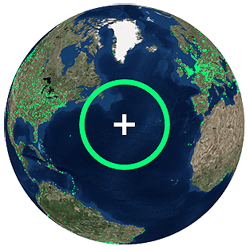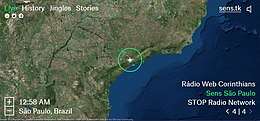Radio Garden
Radio Garden is a non-profit Dutch radio and digital research project developed from 2013 to 2016, by the Netherlands Institute for Sound and Vision (under the supervision of Martin Luther University of Halle-Wittenberg's Goal Föllmer), by the Transnational Radio Knowledge Platform and five other European universities.[1] It is funded by HERA. According to the service, the idea is to narrow the boundaries from the radio.[2] It gained popularity in 2016 when it surpassed the 8,000 registered station mark and, as announced at The Radio Conference 2016: Transnational Encounters, went viral.
 | |
| City | Hilversum, Netherlands |
|---|---|
| Branding | Radio Garden |
| Affiliations | Independent |
| Founded | 2015 |
| Website | https://radio.garden |
Operation and functionality
The site interface is a three-dimensional geolocation, where the user navigates through a representation of the globe, listening to broadcasts of local radio stations, referring in some way to the technology of shortwave radios, long distances, but in this case the means of propagation of the radio edition is by data packets (streaming).[3] The homepage, titled Live, allows the user to explore the world in real time, listening to what the local radios are broadcasting. To do this, it is just necessary to simply rotate the globe. It also provides information on the country where the signal is being transmitted.
Variety and design
Within Radio Garden, radios are arranged by geolocation and grouped by cities. According to specialized websites, the design is formed by greenish spheres superimposed on the map, which increases in size as the region's number of broadcasters available. This idea was developed by the German companies Studio Puckey and Studio Moniker in partnership with the Netherlands Institute for Sound and Vision. Radios are available at locations such as Aleppo, Havana, Sri Lanka, London, North Korea, in addition to New York, Lisbon, Moscow, etc.[4]
On 14 March 2020, a new version, with improved designed and features, was released.
Interface and conversion
The site adopted the generic .garden Top-level domain, which was originally intended for gardening professionals and, as noted on specialized websites, the interface is all responsive and fits any browser and resolution. For transmission, the signal generated by the broadcaster must be converted from radio to streaming editing. The service depends on an internet connection to function. Supported conversion formats for streaming are MP3, Ogg and AAC.

References
- "Two of the visionaries behind Radio.garden". www.radiodayseurope.com. 2017-03-17. Retrieved 2019-10-22.
- "This site lets you listen to thousands of radio stations around the world and it's incredible". The Independent. 2016-12-16. Retrieved 2019-10-22.
- Coldwell, Will (December 16, 2016). "Want to tune in to the world's radio stations? Grow your listening with Radio.Garden" – via www.theguardian.com.
- LaFrance, Adrienne (2016-12-12). "The Map That Lets You Listen to the Radio Everywhere". The Atlantic. Retrieved 2019-10-22.